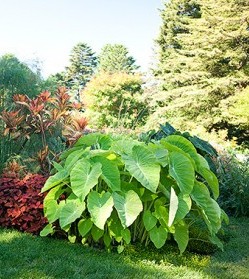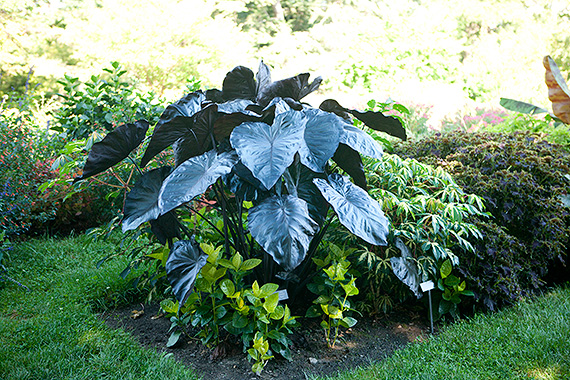Treat Yourself to Some Taro
Posted in Horticulture on October 8 2014, by Sonia Uyterhoeven
Sonia Uyterhoeven is NYBG‘s Gardener for Public Education.

Last week, I discussed the various taros or elephant’s ears (Colocasia esculenta) that we had on display in the Home Gardening Center. What I didn’t mention was that these robust tropical plants with their gigantic floppy leaves and their large round corms can be edible when properly prepared. Taro—or Cocoyam, or Yu Yu Tou—is a popular staple for many cultures.
It is believed that taro is indigenous to India. In Southeast Asia, it was grown near or in rice fields. In ancient times the Greeks and the Romans brought taro to Egypt and the Mediterranean. Spanish and Portuguese explorers then transported it to the New World. It is revered in Hawaii through prayers and takes on many forms in the cuisine. It goes without saying that taro is a globally important food source.
These days, if you wander down to Chinatown, you will find taro balls stuffed with meat and savory taro root cakes. If you have a sweet tooth, you can also find taro ice cream. If you stumble upon a trendy restaurant in SoHo, you can dine on taro chips. Hawaiians pulverize taro to make a starchy paste called poi, and the leaves are used to wrap food or used as vegetables in a stew. In the Caribbean, the corms are shredded and mixed with vegetables and fish to make tasty fritters called acras.

Taro comes from the Araceae family and is related to anthurium, philodendrons, and skunk cabbage. Like many members of the arum family, however, it contains oxalic acid which acts as an irritant to skin, eyes, and digestion. It can make your skin feel as if you have been stuck by a thousand needles. While both the corm and the leaves are edible, they both need to be cooked thoroughly to break down the oxalic acid. This is important!
Once the oxalic acid is broken down, the taro is delicious. The foliage is reminiscent of spinach and the corm tastes like a sweet and nutty potato. The taro root is high in fiber, boasts a low caloric content, and is loaded with vitamins and minerals such as Vitamin B6, C, E, potassium and manganese. The leaves are high in Vitamin A and C, while they also contain calcium, iron, and manganese.
The taro root can be pulverized and made into flour or steamed, boiled, mashed, roasted, or fried. The leaves can be boiled or steamed. In Hawaii, they wrap food in the large taro leaves and steam them for several hours. The wrapped taro leaves are called laulau. In the Caribbean, taro leaves are known as callaloo.
There are many recipes to be found in cookbooks and on the internet. To start with the easiest, try making taro chips. Heat your oven to 400 degrees Fahrenheit. Coat your baking sheet with a thin layer of olive oil. Peel the taro root and slice it into thin chips (about 1/16 inch thick) or use a mandoline slicer.
Place on the baking sheet and brush the top of the chips with a thin layer of oil. Season your taro chips with salt and pepper, and bake for approximately 12 to 15 minutes. Remove the chips when they’re turning golden brown and just starting to curl. Let cool and enjoy with your favorite dip or sandwich.
In the coming weeks, I will shift from the exotic to the familiar. This Columbus Day Weekend (October 11–13), I will conduct a hands-on Home Gardening Demonstration in the Perennial Garden on autumnal centerpieces using heirloom pumpkins, groovy gourds, and traditional pie pumpkins. The blogs for the next two weeks will complement this demonstration.

